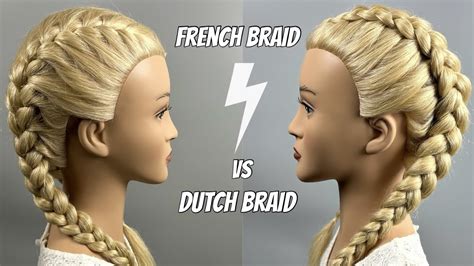Introduction

Braids, an ancient and versatile hairstyle, have adorned heads for centuries. Two iconic variations, the French braid and the Dutch braid, each possess distinct characteristics and advantages. This comprehensive guide delves into the intricate details of these two techniques, empowering you with the knowledge to make an informed choice for your next braid.
Key Differences
| Feature | French Braid | Dutch Braid |
|---|---|---|
| Origin | France | Netherlands |
| Technique | Underhand | Overhand |
| Appearance | Flatter | Raised |
| Difficulty | Moderate | Easier |
French Braids
- Underhand Weaving: Strands are passed under the central section, creating a flat, inverted braid pattern.
- Bulky Texture: The underhand technique produces a fuller, more intricate appearance.
- Versatile Styling: French braids can be worn in various forms, including buns, crowns, and side braids.
- Versatile Styling: Can be styled in numerous ways to suit different occasions.
- Secure Hold: Holds hair securely in place, preventing tangles and flyaways.
- Easy Maintenance: Requires minimal upkeep and can last for several days.
- Difficult to Master: Can be challenging to learn and requires practice to perfect.
- Tightness: The underhand weaving can create tension on the scalp, making it uncomfortable for some.
- Bulky Appearance: The bulky texture may not be suitable for all hair types or styles.
Dutch Braids
- Overhand Weaving: Strands are passed over the central section, resulting in a raised, rope-like braid pattern.
- Texture: Creates a more textured and voluminous braid compared to French braids.
- Visual Impact: The raised texture makes Dutch braids stand out from other braiding techniques.
- Easier to Learn: The overhand weaving technique is simpler to master than French braids.
- Less Tightness: The overhand method creates less tension on the scalp, making it more comfortable to wear.
- Voluminous Appearance: Provides a voluminous and dramatic braid, ideal for special occasions.
- Less Versatile: Dutch braids have fewer styling options compared to French braids.
- Loosening: The overhand weaving can be less secure, making the braid prone to loosening.
- Less Common: Not as popular as French braids, so may not be available at all salons.
Which Braid Is Right for You?
The choice between French and Dutch braids ultimately depends on your individual preferences and hair type. Here are some questions to help you make an informed decision:
- What is your skill level: French braids require more skill to master, while Dutch braids are easier to learn.
- Do you prefer a flat or raised look: French braids create a flatter appearance, while Dutch braids provide a raised effect.
- How much volume do you want: Dutch braids create more volume compared to French braids.
- How secure do you need your braid to be: French braids offer a more secure hold, while Dutch braids may be prone to loosening.
Modern Applications
In recent years, French and Dutch braids have evolved beyond their traditional uses and have been incorporated into various innovative applications:
- Braided Hair Extensions: Braids can be used to seamlessly blend hair extensions into natural hair, creating a voluminous and stylish look.
- Braided Hair Sculptures: Skilled braiders create intricate hair sculptures using French and Dutch braids, transforming hair into wearable art.
- Braided Hair Accessories: Braids can be integrated into hair accessories such as headbands, buns, and hair wraps, adding a touch of sophistication and elegance.
Conclusion
French and Dutch braids offer distinct advantages and drawbacks, catering to different preferences and hair types. Whether you desire a flat and intricate braid or a voluminous and visually striking option, these techniques provide endless possibilities for creative hairstyling. By understanding the differences between French and Dutch braids, you can make an informed choice that enhances your personal style and reflects your unique personality.
-
Q: Which braid is more secure, French or Dutch?
A: French braids offer a more secure hold due to the underhand weaving technique. -
Q: Can both French and Dutch braids be used on short hair?
A: Yes, both techniques can be adapted to work on shorter hair, although Dutch braids may be more suitable. -
Q: How often should Dutch braids be taken out?
A: Dutch braids can last for several days, but should be removed after 3-4 days to prevent damage. -
Q: Can French braids cause hair breakage?
A: Yes, if braided too tightly or worn for excessive periods. -
Q: What are the best hair types for French and Dutch braids?
A: Both braids work well on most hair types, but thicker hair holds braids better. -
Q: Can French and Dutch braids be combined into one style?
A: Yes, creating a hybrid braid that combines elements of both techniques. -
Q: How can I prevent Dutch braids from loosening?
A: Use hairspray or mousse while braiding and secure the ends with an elastic band. -
Q: What is the most popular French braid style?
A: The classic three-strand French braid remains the most popular style.
Additional Resources
French Braid Tutorial
Dutch Braid Tutorial
Hair Braiding Salon Locator
